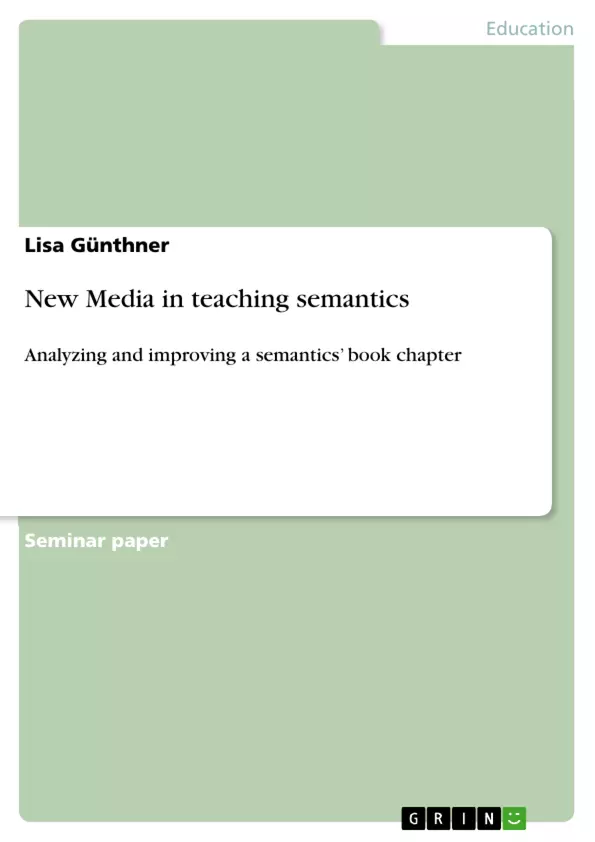We are living in a new media age. Computers, DVDs, CDs and the internet including YouTube, wikis and other websites are a part of many people´s everyday life. According to the Internet World Stats, about two billion people used the internet in 2012 with North America (78.6% of the population), Australia (67.6%) and Europe (63.2%) leading the way (Internet World Stats).
Using New media is natural for the children of our society as they grow up with it. They live in a world where CDs, DVDs, computers and mobile phones are just given. When they first use the internet, they are on average about nine years old (Livingstone, Haddon et al., p.23).
As it is so frequently used, it is no wonder that new media has also found its way into today’s classrooms offering great possibilities of learning and communication to teachers and students.
At the Johann Wolfgang Goethe University in Frankfurt in the winter session 2012/2013, a course was offered, called “New media in teaching semantics” by Professor Manfred Sailer. In this course, his students got to know different types of new media and how those could be used in teaching semantics. Furthermore, they designed online material for a semantics’ introductory course and created an own wiki including podcasts, material for an interactive whiteboard and topic related explanations and tasks.
At the moment, Professor Manfred Sailer is working on a book on semantics which is also used in the mentioned introductory course. In this paper, the chapter on “Predicate logic” will be analyzed. Therefore, it will be compared to other books on the same topic and evaluated from the viewpoint of a student having completed both mentioned courses. Furthermore, additional e-learning material will be created for the mentioned book chapter. The advantages of that will be explained.
Inhaltsverzeichnis (Table of Contents)
- Introduction
- Comparison to other books on semantics
- "Formale Semantik und natürliche Sprache" by Horst Lohnstein
- "Logic, Language and Meaning. Introduction to Logic" by L.T.F. Gamut
- "Mathematical Methods in Linguistics" by Barbara H. Partee, Alice ter Meulen and Robert E. Wall
- Evaluation from the viewpoint of a student
- E-learning material
- Why not only use a book?
- Additional e-learning material
- Conclusion
Zielsetzung und Themenschwerpunkte (Objectives and Key Themes)
This paper analyzes the "Predicate logic" chapter of a forthcoming book on semantics. The chapter is compared to similar chapters in other books and evaluated from a student's perspective. Additionally, the paper explores how e-learning materials could enhance the chapter.
- Comparison of the "Predicate Logic" chapter with other books on formal semantics
- Evaluation of the chapter from a student's perspective
- Exploration of the use of e-learning materials in teaching formal semantics
- Analysis of the strengths and weaknesses of the "Predicate Logic" chapter
- Identification of potential improvements to the chapter
Zusammenfassung der Kapitel (Chapter Summaries)
Introduction
The paper sets the context of the new media age and the increasing use of computers, internet, and related technologies in education. It highlights the importance of integrating new media in teaching semantics and outlines the specific focus of the paper: analyzing the "Predicate Logic" chapter of a forthcoming book on semantics.
Comparison to other books on semantics
This chapter compares the "Predicate Logic" chapter with similar chapters in three other books on formal semantics: "Formale Semantik und natürliche Sprache" by Horst Lohnstein, "Logic, Language and Meaning. Introduction to Logic" by L.T.F. Gamut, and "Mathematical Methods in Linguistics" by Barbara H. Partee, Alice ter Meulen and Robert E. Wall. The comparison focuses on the presentation of the topic, the level of detail, and the assumed prior knowledge of the reader.
Evaluation from the viewpoint of a student
This chapter provides an evaluation of the "Predicate Logic" chapter from the perspective of a student who has completed the course on "New Media in Teaching Semantics." It analyzes the strengths and weaknesses of the chapter, considering its clarity, accessibility, and potential for student engagement.
E-learning material
This chapter explores the potential for using e-learning materials to enhance the "Predicate Logic" chapter. It discusses the benefits of incorporating interactive exercises, multimedia content, and online resources to improve student understanding and engagement.
Schlüsselwörter (Keywords)
This paper explores key topics including formal semantics, predicate logic, e-learning materials, and the role of new media in teaching semantics. The analysis focuses on the effectiveness of existing text-based materials in conveying complex concepts in formal semantics and proposes the use of interactive and multimedia learning tools to enhance student engagement and understanding.
- Citation du texte
- Lisa Günthner (Auteur), 2013, New Media in teaching semantics, Munich, GRIN Verlag, https://www.grin.com/document/276508



